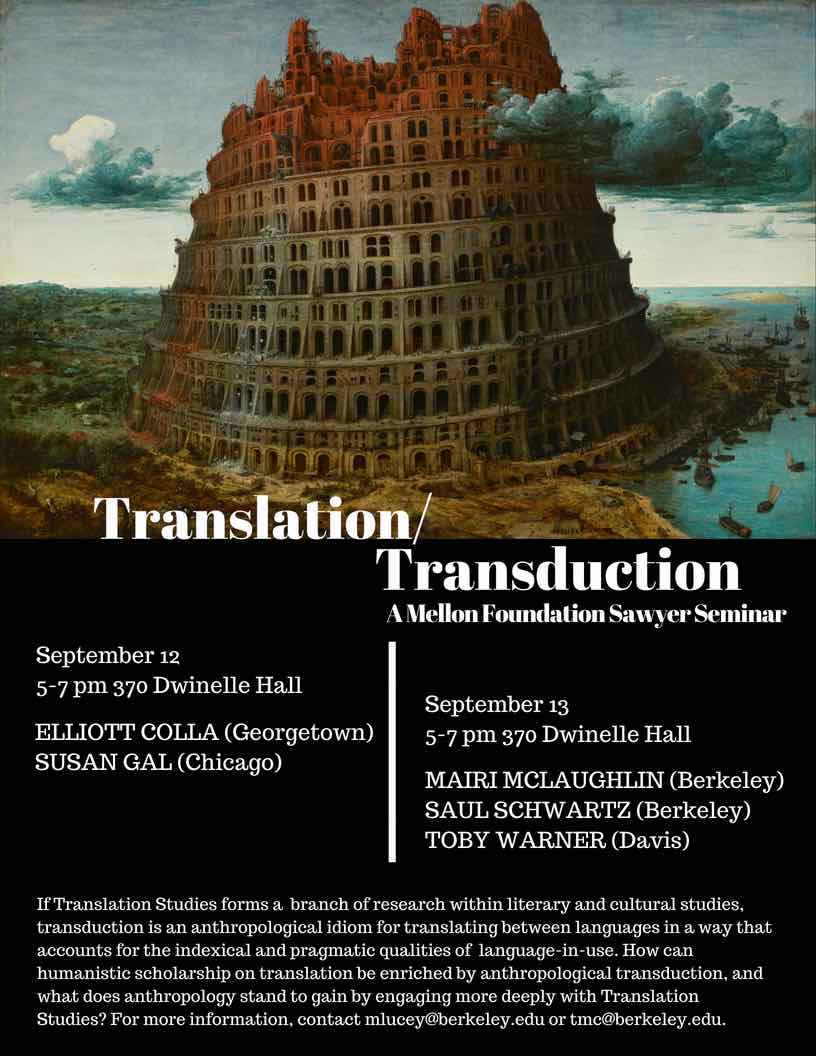Sawyer Seminar on Linguistic Anthropology and Literary and Cultural Studies: Translation/Transduction
This first of seven two-day seminars exploring the potential of a set of concepts, tools, and critical practices developed in the field of linguistic anthropology for work being done in the fields of literary and cultural criticism takes place Wednesday and Thursday, September 12 and 13, from 5-7 pm in 370 Dwinelle Hall, UC Berkeley. With presentations by Susan Gal (Chicago) and Elliott Colla (Georgetown) on September 12, and by Mairi McLaughlin (Berkeley), Saul Schwartz (Berkeley), and Toby Warner (Davis) on September 13. For information on the seminar’s working group and background readings, please contact Michael Lucey (mlucey@berkeley.edu) or Tom McEnaney (tmc@berkeley.edu).
Category Archives: Uncategorized
Fact Meets Fiction in Selma
Selma and the Place of Fiction in Historical Films
by Jeffrey Knapp
The essay begins:
 “This isn’t right.” Almost as soon as the man resembling Martin Luther King Jr. has begun to speak, he interrupts himself in frustration. “I accept this honor,” he’d been saying, “for our lost ones, whose deaths pave our path, and for the twenty million Negro men and women motivated by dignity and a disdain for hopelessness.” What does he think isn’t right? Is it the racial oppression he has been evoking? Or is it the felt inadequacy of his words to that injustice? As the man turns away from us, we find that he has been speaking into a mirror, and that he is frustrated in the immediate context by his efforts at getting dressed . “Corrie”—it is King, we now understand, and he’s not alone; his wife Coretta is with him—“this ain’t right.” “What’s that?” she asks, entering from another room. “This necktie. It’s not right.” “It’s not a necktie,” she corrects him, “it’s an ascot.” “Yeah, but generally, the same principles should apply, shouldn’t they? It’s not right.”
“This isn’t right.” Almost as soon as the man resembling Martin Luther King Jr. has begun to speak, he interrupts himself in frustration. “I accept this honor,” he’d been saying, “for our lost ones, whose deaths pave our path, and for the twenty million Negro men and women motivated by dignity and a disdain for hopelessness.” What does he think isn’t right? Is it the racial oppression he has been evoking? Or is it the felt inadequacy of his words to that injustice? As the man turns away from us, we find that he has been speaking into a mirror, and that he is frustrated in the immediate context by his efforts at getting dressed . “Corrie”—it is King, we now understand, and he’s not alone; his wife Coretta is with him—“this ain’t right.” “What’s that?” she asks, entering from another room. “This necktie. It’s not right.” “It’s not a necktie,” she corrects him, “it’s an ascot.” “Yeah, but generally, the same principles should apply, shouldn’t they? It’s not right.”
This opening to Selma announces the complexity not only of the movie itself but also of the genre to which it belongs—the historical film. First, there is the tonal instability of the scene, which swerves from the tragedy of “our lost ones” to the comedy of the ascot. Then there is the rhetorical switch from King’s earnest and formal speech to the colloquialism of his “ain’t” and the domestic ease of his “Corrie.” As the film reviewer Michael Sragow comments, these transformations seem intended “to signal to audiences that we’re in for an intimate, maybe irreverent look” at King; in general, A. O. Scott argues, Selma is dedicated to “restoring” King’s “human dimensions.” But the start of Selma also briefly confuses us about the meaning of a word that one might have assumed was the last one the movie would want us to feel confused about: “right,” as in “the right to vote,” “the right to assemble, and demonstrate,” “equal rights,” “civil rights.” “I don’t like how this looks,” King says of his ascot: what’s troubling him seems to be an aesthetic, not a moral offense. Another change in emphasis apparently neutralizes that distinction. When Coretta replies that the ascot “looks distinguished and debonair to me,” King clarifies that his objection has all along had a moral dimension to it. “You know what I mean,” he says to his wife: the ascot makes it seem “like we’re living high on the hog dressed like this, while folks back home are . . . It’s not right.” Just as King wants the language of his speech to match the weightiness of its subject, so he’s concerned that his clothes reflect his social commitments; in aesthetics as in ethics, he believes, “the same principles should apply.” Yet the disorienting shifts of focus in this first scene nevertheless emphasize the potential for principles to become misaligned. Something else “isn’t right” at the start of Selma: the man who speaks these words, the British actor David Oyelowo, is after all merely pretending to be Martin Luther King Jr., and for a moment we might think that he’s expressing nothing more than his dissatisfaction with his performance. The opening to Selma seems, in other words, to anticipate two sorts of skeptical responses to the film: first, that Selma falls short as a historical recreation, and second, that it does so because of its trivializing overinvestment in such merely aesthetic questions as how the recreation “looks.”
These are indeed the very charges that have been leveled against the film, although they have centered less on the portrayal of King than on the representation of another historical figure in the movie, Lyndon Johnson. In an editorial for the Washington Post, the former Johnson aide Joseph Califano Jr. argued that
the makers of the new movie Selma apparently just couldn’t resist taking dramatic, trumped-up license with a true story that didn’t need any embellishment to work as a big-screen historical drama. As a result, the film falsely portrays President Lyndon B. Johnson as being at odds with Martin Luther King Jr. and even using the FBI to discredit him, as only reluctantly behind the Voting Rights Act of 1965 and as opposed to the Selma march itself.
In Selma, Califano charged, aesthetics “trumped” ethics: the producers, screenwriter, and director felt “free to fill the screen with falsehoods, immune from any responsibility to the dead, just because they thought it made for a better story.” Even reviewers more sympathetic to the film have agreed with Califano about its misrepresentation of LBJ. Though praising Selma as “the best depiction of the civil rights struggle of the 1960s,” Albert R. Hunt nevertheless added that “it needlessly, and erroneously, casts Johnson as a reluctant supporter of the Voting Rights Act”; so, too, Ari Berman characterized the film’s account of Johnson as “unnecessarily one-sided.” What troubled all three critics was how “needlessly,” in their view, the makers of Selma had set their aesthetic desire for dramatic “embellishment” against a moral “obligation” to “the facts.”
Proponents of Selma have by and large declined to defend the historical accuracy of Johnson’s portrayal in the film, instead choosing to criticize the very demand for accuracy as hopelessly naive. “Did ‘Selma’ cut some corners and perhaps tilt characters to suit the needs of the story?” David Carr asked. “Why yes—just like almost every other Hollywood biopic and historical film that has been made.” Differentiating Selma from “a documentary or even a dramatized history,” Jamelle Bouie defined it as “a film based on historical accounts, and like all films of its genre, it has a loose relationship to actual history.” Consequently, Bouie added, “it’s better to look at deviations from established history or known facts” in Selma not as defects but rather “as creative choices—license in pursuit of art.” “I’m not a historian. I’m not a documentarian,” Selma’s director Ava DuVernay similarly maintained in a televised interview with Gwen Ifill: “This is art. This is a movie. This is a film.” According to the reviewer Bilge Ebiri, the only relevant terms for judging the rightness of historical films are aesthetic ones: “These movies are not documentaries, nor are they acts of journalism. . . . They’re narrative works, and just like any other narrative work, they need to be true to themselves.”
“Every year,” the film scholar Jeanine Basinger wearily complained when asked to comment on Selma, “I know someone is going to call me about distortion of history when we hit the Oscars.” But there’s a reason that the objection keeps recurring. If it’s a mistake to look for accuracy in historical films, then why do historical films bother with accuracy at all? Although DuVernay rejected the label of documentarian in her interview with Ifill, that is exactly how she began her directorial career, with the hip-hop documentary This Is the Life (2008)—and her next project after Selma was a documentary on the US criminal justice system, 13th. What’s more, historical verisimilitude mattered enough to DuVernay in making Selma that she meticulously reproduced the look and feel of the sixties in her film, chose actors who bore an uncanny physical resemblance to the figures they played, and even spliced actual documentary footage of the final march to Montgomery into Selma’s recreation of it. In the same interview where she claimed that she was no more of a historian than a documentarian, DuVernay expressed her dismay at the “jaw-dropping” ignorance of moviegoers regarding the events her film “chronicled,” and she hoped that her movie would help Selma “resonate with people in the way that it should as being just such a cornerstone of democracy.” Prominent participants in the march have indeed championed the film as historiography. “Everything” except the film’s “depiction of the interaction between King and Johnson,” Andrew Young has said, “they got 100 percent right.” But then how could historical accuracy not be an issue for a film that ends with King’s proclaiming, “His truth is marching on”? The tensions between fact and fiction in Selma are anything but incidental to the movie: they instead reflect the irreducibly hybrid nature of the historical film.
Is it possible to argue that a mix of fact and fiction is necessary to Selma and to historical films generally? Continue reading …
Every historical film must contend with the possibility that its viewers will be scandalized by its mixture of fact and fiction, but no recent historical film has faced such pressure to justify its hybrid nature as Selma has, in large part because no recent film has taken on so momentous and controversial a historical subject: the civil rights marches from Selma to Montgomery that led to the passage of the Voting Rights Act in 1965. The renewed urgency of the issues Selma dramatizes, along with the film’s own commitment to the “moral certainty” of the civil rights movement, helps explain why Selma wavers in a self-defense that links the fictionality of its historical reenactments to the purposely theatrical element of the marches themselves. But politics are not the only problem for fiction in Selma, and to show why, this essay compares Selma to an earlier historical film, The Westerner (1940), that openly flaunts the commercial nature of its fictionality.
JEFFREY KNAPP is the Eggers Professor of English at the University of California, Berkeley, and a Faculty Affiliate of Berkeley’s Film and Media Department. He is most recently the author of Pleasing Everyone: Mass Entertainment in Renaissance London and Golden-Age Hollywood, published in 2017 by Oxford University Press.
Cuban Corals in East Berlin’s Natural History Museum, 1967–74
Cuban Corals in East Berlin’s Natural History Museum, 1967–74
by Manuela Bauche
The essay begins:

On October 7, 1974, the German Democratic Republic (GDR) turned twenty-five. Among the events commemorating this anniversary was a temporary exhibition that opened within East Berlin’s Natural History Museum, the Museum für Naturkunde. The show, entitled Forschung im Museum (Research at the museum), aimed to give an overview of the diversity of research conducted at the GDR’s most important natural history museum during the first quarter-century of the republic’s existence. Included was an impressive exhibit: a coral-reef diorama. The exhibition occupied one room on the ground floor of the museum. Depending on which side visitors entered, the diorama would be either the first exhibit they encountered or, after a long row of glass cabinets bearing information and evidence of the museum’s research activities, the last. The diorama’s plain chipboard wall was three meters high and five meters wide. In its center, a glass window invited visitors to peek inside. Within could be seen a submarine landscape: a slope of sand-colored coral rock, which, while slightly rising up toward the surface of the water, disappeared into the depth; ball-like corals with delicately grooved yellowish and brownish surfaces strewn about the sea floor; in the foreground, a group of bright blue fish, all heading in the same direction, eyes seemingly fixed on an invisible goal; and a small black and yellow fish coming toward them. On the lower left, a gaping hole in the rock formation revealed a glimmering blue, foreshadowing deeper waters and allowing yet another fish entrance into the coralline world.
The new exhibit fascinated Berliners. The press praised it as a “gorgeously colorful, lifelike detail of a Cuban bank reef,” at times even omitting the fact that the diorama—made of dried and dead coral specimens, fish casts, plaster, steel, and glass—in fact was a waterless representation of a reef. Indeed, newspapers proudly announced that the Museum für Naturkunde now held “a coral reef with colorful flora and fauna” that showed a “confoundingly colorful life, diverse in terms of both forms and species, in the midst of bizarre coral formations.” But just as fascinating as the diorama itself was the process of its coming into being. Its construction had entailed experimentation with different types of dyes, inventiveness in the face of scarce resources, and, of course, the application of technical skill and patience.
In 1967, even before the construction of the diorama, a team of researchers from Berlin had conducted an ambitious expedition to Cuba to collect corals and make casts of the fish that would form the centerpiece of the exhibit. After an Atlantic crossing of more than nine weeks, two scientists, two preparators from the Museum für Naturkunde, a doctor, and a seaman from the GDR’s Society for Sports and Technology (Gesellschaft für Sport und Technik, GST) reached Havana. With them more than seventy boxes of equipment, several small boats, and a truck were unloaded. There they joined four divers from the GST who had arrived by plane and had already set up an expedition camp on the island’s north shore, seventy kilometers east of Havana, at a spot called Arroyo Bermejo.
The expedition’s aim was to collect enough corals and other specimens from the reef lining the shore to reconstruct a ten-meter-long section in the Museum für Naturkunde’s exhibition. Over the course of three weeks, the GST divers towed a raft to the reef that paralleled the shore at a distance of a few hundred meters, dived into the reef to break corals out of the chalk structure, lifted them to the raft, and delivered them to the expedition camp. The museum staff then scattered the corals on the beach to dry, clean, and gradually pack them into the boxes they had taken care to bring with them from Berlin. In the end, forty-one boxes of approximately six to ten tons of reef material were shipped to the GDR. Seven years later, instead of the envisaged ten-meter-long reconstruction, [a much smaller] diorama . . . was realized.
To understand the significance of the expedition, it must be seen in the context of the diplomatic ties established between Cuba and the GDR in the fields of science and education. In 1962, only three years after the Cuban Revolution, the University of Havana and East Berlin’s Humboldt University had agreed on a joint “Treaty of Friendship and Cooperation” that allowed for a regular and systematic exchange of students, lecturers, scientists, and publications. Beyond this, a number of other points of collaboration were established between scientific institutions in the two countries: in 1966, the “Tropenforschungsinstitut Alexander von Humboldt” (Alexander von Humboldt Tropical Research Institute) was founded as a joint institute of the Cuban and GDR academies of sciences; and, from 1974 on, botanists from the universities of Jena and Berlin and scientists from Havana’s National Botanical Garden worked, in bi-annual expeditions, toward a comprehensive register of Cuba’s flora. The Cuban side had been particularly interested in establishing these kinds of international collaborations, hoping that they would help to build the scientific capacities urgently needed in the newly founded republic. Among the socialist states with which Cuba maintained scientific relations, the GDR ranked second—after the Soviet Union and ahead of Bulgaria. From a GDR perspective, Cuba was an important partner for activities that needed a tropical environment, as it was one of the few tropical socialist countries and thus politically accessible to the East German state.
Looking at the exhibition—in which only a small portion of the material collected ultimately appeared (in the diorama), and then only several years after the trip to Cuba—it is striking that the museum did not feature the idea and practice of socialist friendship more prominently, especially since Cuban divers, too, had taken part in the endeavor. Indeed, the anniversary of the country’s founding might have provided a perfect opportunity to highlight the importance of this political framework. The only hint of the existence of the expedition itself was a map of Cuba, on which the place where the corals had been collected was marked. Apart from this, the exhibition focused solely on educating the public on the biology of corals and the formation of coral reefs, its descriptive panels detailing the museum’s “coral-reef research in Cuba,” in conformance with the exhibition’s overall agenda of presenting examples of the museum’s research. The special Cuban-GDR relation that had provided the foundation for the genesis of the diorama remained invisible.
Why did the Museum für Naturkunde opt to present Cuban corals in this particular manner? What happened to socialist internationalism along the (corals’) way? In their contributions to this Representations forum, Alice Goff and Mario Schulze show that international diplomacy was an important precondition for the transfer of objects across national boundaries, and that both the design and the planning of exhibitions were at times intimately linked to global political realities such as Cold War competition. In what follows, I examine the effect of global politics and diplomacy on both the coral-reef expedition of 1967 and the 1974 display of the diorama that resulted from it. I will show that although bilateral agreements were an important precondition for both projects, informal contacts between players beyond the political field were at least as crucial. I question the assumption that objects that crossed political and state borders during the Cold War for exhibition purposes were always and as a matter of principle intertwined with high-level diplomacy, that they would necessarily carry political meaning or act as “ambassadors” in international relations. Instead, I show that although the appropriation and transfer of objects could not have been accomplished without a diplomatic framework, it could just as easily come about as a result of contacts between players operating beyond the official political field, in this case divers from the GDR and Cuba.
In this way, my account of the history of the coral-reef diorama also departs from the popular depiction of political and cultural life within socialist countries, and of exchange between them, as generally being organized from the top down and rigidly controlled. Instead, I join with current research that argues for a more complex idea of what “socialist friendship” meant on the practical level and shows that transnational exchange between socialist countries at times occurred beyond high-level politics. Continue reading …
This essay reconstructs the history of a coral-reef diorama, the outcome of a German Democratic Republic expedition to Cuba, that was displayed in East Berlin’s Natural History Museum in 1967 on the occasion of the GDR’s twenty-fifth anniversary. The essay investigates how the practice of socialist internationalism influenced the diorama’s coming into being, arguing that while official diplomatic relations between Cuba and the GDR were a prerequisite for the expedition, nongovernmental contacts were central to both the initiation and execution of the project. It also demonstrates how the diorama’s display was informed more by national and institutional concerns than by the rhetoric and policies of internationalism.
MANUELA BAUCHE is a historian and postdoctoral researcher at Berlin’s Natural History Museum. Her research interests lie in the global history of life sciences and scientific expeditions in the twentieth century.
New Special Issue, Representations 140
NOW AVAILABLE
Number 139, Summer 2017 (read for free at UC Press)
Special Issue: FALLACIES
Where does the history of fallacies leave the contemporary critic?
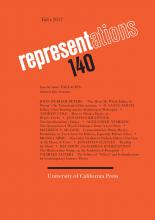 It is hard not to see that we are living in in an especially fallacious age; fallacies are evidently psychologically compelling. They appeal to our fear, anger, or pity; to our respect for authority; or to our faith in the power of numbers. A president will be blamed for an economic downturn that precedes him or credited for job growth that is inconsequent to his acts. As mistakes of logic, fallacies are not lies and not exactly nonsense either. Fallacies, in other words, are things that, not being valid, “are susceptible of being mistaken” for valid.
It is hard not to see that we are living in in an especially fallacious age; fallacies are evidently psychologically compelling. They appeal to our fear, anger, or pity; to our respect for authority; or to our faith in the power of numbers. A president will be blamed for an economic downturn that precedes him or credited for job growth that is inconsequent to his acts. As mistakes of logic, fallacies are not lies and not exactly nonsense either. Fallacies, in other words, are things that, not being valid, “are susceptible of being mistaken” for valid.
In this collection of essays, eleven scholars of literature, logic, philosophy, film, and art history take up a variety of ways in which, in our disciplines and critical practices, truth appears. The essays, in explaining a few of the well-known fallacies and naming others, are all concerned with ways of reading that bring ideas and experiences to a subject that are not germane to the subject. They ask us to look, as I. A. Richards does, at “instances of irrelevance” in thinking, at what fits and doesn’t fit or is there by accident. They raise our awareness of those “inadequate” revelations that W. K. Wimsatt and Monroe Beardsley, in their famous essay on the intentional fallacy, tried to arm us against and exclude from critical judgment “like lumps from pudding and ‘bugs’ from machinery.”
To return to the question of fallacies in the twenty-first century is to ask what is most material to our arguments if we want them to be practical and satisfying and if, in Beardsley’s words, “we wish to get out of them what is most worth getting.”
Introduction: The Issue with Fallacies
“You Mean My Whole Fallacy Is Wrong”: On Technological Determinism
John Durham Peters
Fallacy: Close Reading and the Beginning of Philosophy
How to Think a Figure; or, Hegel’s Circles
The Destruction of Hood’s Ordnance Train: A Love Story
Alexander Nemerov
Materialist Vitalism or Pathetic Fallacy: The Case of the House of Usher
The Hitchcockian Nudge; or, An Aesthetics of Deception
,
The Fallacy of “Fallacy” and Its Implications for Contemporary Literary Theory
Charles Altieri
On Race in Art
Black Futures: On Race in Art, Curation, and Digital Engagement
with Kimberly Drew in conversation with Stephen Best

Arts + Design Mondays @ BAMPFA
Monday, October 16, 6:30pm
UNIVERSITY OF CALIFORNIA, BERKELEY ART MUSEUM & PACIFIC FILM ARCHIVE
2155 Center Street, Berkeley
Kimberly Drew has been dubbed an “international tastemaker in contemporary art” on account of her Tumblr blog Black Contemporary Art and her Instagram @museummammy. As social media manager at the Metropolitan Museum of Art, she has been pivotal in moving that venerated institution in directions both democratic and dialogical. Drew will discuss curation, social media, race, and institutions with UC Berkeley professor Stephen Best.
Kimberly Drew is a writer and curator based in New York City. Drew received her BA from Smith College in art history and African-American studies, with a concentration in museum studies. She first experienced the art world as an intern in the director’s office of the Studio Museum in Harlem, where she was inspired her to start her blog and to pursue her interest in social media as it relates to the arts.
A member of the Representations editorial board, Stephen Best is an associate professor of English at UC Berkeley and the author of The Fugitive’s Properties: Law and the Poetics of Possession, a study of property, poetics, and legal hermeneutics in nineteenth-century American literary and legal culture. He co-convened a research group at the University of California’s Humanities Research Institute on “Redress in Law, Literature, and Social Thought” that led, in part, to the special issue “Redress” in 2005. He is also the co-editor of the 2009 special issue “The Way We Read Now” and the 2016 volume “Description Across Disciplines.”
Advance Look: Jeffrey Knapp on “Selma”
In recognition of the speed at which the world and its histories are changing, we’ve just posted an advance version of “Selma and the Place of Fiction in Historical Films” by Jeffrey Knapp. The essay will appear in print and online in our Winter 2019 issue, but you can read it here right now.
In the essay, Knapp compares the place of historical fictionality in William Wyler’s 1940 film The Westerner and Ava DuVernay’s 2014 Selma.
“’This isn’t right,’” the essay begins, in the voice of Martin Luther King as depicted by David Oyelowo, in Selma. “Almost as soon as the man resembling Martin Luther King Jr. has begun to speak, he interrupts himself in frustration. ‘I accept this honor,’ he’d been saying, ‘for our lost ones, whose deaths pave our path, and for the twenty million Negro men and women motivated by dignity and a disdain for hopelessness.’ What does he think isn’t right? Is it the racial oppression he has been evoking? Or is it the felt inadequacy of his words to that injustice? As the man turns away from us, we find that he has been speaking into a mirror, and that he is frustrated in the immediate context by his efforts at getting dressed. ‘Corrie’ — it is King, we now understand, and he’s not alone; his wife Coretta is with him — ‘this ain’t right.’ ‘What’s that?’ she asks, entering from another room. ‘This necktie. It’s not right.’ ‘It’s not a necktie,’ she corrects him, ‘it’s an ascot.’ ‘Yeah, but generally, the same principles should apply, shouldn’t they? It’s not right.’” Read full article …
JEFFREY KNAPP is the Eggers Professor of English at UC Berkeley and author of An Empire Nowhere: England and America from Utopia to The Tempest (1992); Shakespeare’s Tribe: Church, Nation, and Theater in Renaissance England (2002); Shakespeare Only (2009); and Pleasing Everyone: Mass Entertainment in Renaissance London and Golden-Age Hollywood, published this year by Oxford University Press. He is also a contributing editor for Representations.
Talk About Pleasing Everyone
Pleasing Everyone: Mass Entertainment in Renaissance London and Golden-Age Hollywood
12:00 pm to 1:00 pm Geballe Room, 220 Stephens Hall, UC Berkeley, Wednesday, Sept. 27, 2017 | 12:00 pm to 1:00 pm Geballe Room, 220 Stephens Hall, UC Berkeley
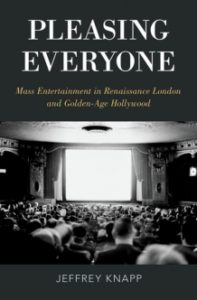 Shakespeare’s plays were immensely popular in their own day yet history refuses to think of them as mass entertainment. In Pleasing Everyone, Professor of English Jeffrey Knapp highlights the uncanny resemblance between Renaissance drama and the incontrovertibly mass medium of Golden-Age Hollywood cinema. Through explorations of such famous plays as Hamlet, The Roaring Girl, and The Alchemist, and such celebrated films as Citizen Kane, The Jazz Singer, and City Lights, Knapp challenges some of our most basic assumptions about the relationship between art and mass audiences and encourages us to resist the prejudice that mass entertainment necessarily simplifies and cheapens.
Shakespeare’s plays were immensely popular in their own day yet history refuses to think of them as mass entertainment. In Pleasing Everyone, Professor of English Jeffrey Knapp highlights the uncanny resemblance between Renaissance drama and the incontrovertibly mass medium of Golden-Age Hollywood cinema. Through explorations of such famous plays as Hamlet, The Roaring Girl, and The Alchemist, and such celebrated films as Citizen Kane, The Jazz Singer, and City Lights, Knapp challenges some of our most basic assumptions about the relationship between art and mass audiences and encourages us to resist the prejudice that mass entertainment necessarily simplifies and cheapens.
After an introduction, Knapp will speak briefly about his book and then open the floor for discussion.
JEFFREY KNAPP is the Eggers Professor of English at UC Berkeley and author of An Empire Nowhere: England and America from Utopia to The Tempest (1992); Shakespeare’s Tribe: Church, Nation, and Theater in Renaissance England (2002); Shakespeare Only (2009); and Pleasing Everyone: Mass Entertainment in Renaissance London and Golden-Age Hollywood, published this year by Oxford University Press. The chapter “Throw That Junk!” in Pleasing Everyone was first published in Representations 122 (Spring 2013). An advance version of his new essay “Selma and the Place of Fiction in Historical Films” will be posted here in early October.
Practices of Resistance
In her essay in our new issue, Debarati Sanyal analyzes practices of resistance as seen through film and photography set in the Calais’s “jungle” refugee encampments, which were razed last year by the French government. She discusses the interplay of humanitarian compassion and securitarian repression in the destruction of the camps, nuancing the view of borderscapes as sites of total biopolitical capture, and of refugees as “bare life.” Making a profound case for both art and resistance, “Calais’s ‘Jungle’: Refugees, Biopolitics, and the Arts of Resistance” is a compelling and visually stunning read.

Still from Qu’Ils reposent en révolte: Des figure de guerres I, by Sylvain George (2010)
DEBARATI SANYAL is Professor of French at the University of California, Berkeley. The author of The Violence of Modernity: Baudelaire, Irony, and the Politics of Form (Johns Hopkins University Press, 2006) and Memory and Complicity: Migrations of Holocaust Remembrance (Fordham University Press, 2015), she is currently at work on a study of testimony, cultural form, and the refugee “crisis.”
Summer Travel Round-Up
Traversing the history of cartography, cross-cultural encounters and discoveries, travelers fortunate and unfortunate, and voyages to the depths of the sea, these travel-related essays make good transit companions for summer journeys.
Ricardo Padrón, “Mapping Plus Ultra: Cartography, Space, and Hispanic Modernity,” Representations 79 (Summer 2002): 28-60.
Sumathi Ramaswamy, “Catastrophic Cartographies: Mapping the Lost Continent of Lemuria,” Representations 67 (Summer 1999): 92-129.
Christopher L. Hill, “Crossed Geographies: Endō and Fanon in Lyon,” Representations 128 (Fall 2014): 93-123.
Michel de Certeau, “Travel Narratives of the French to Brazil: Sixteenth to Eighteenth Centuries,” Representations 33 (Winter 1991): 221-26.
H. G. Cocks, “The Discovery of Sodom, 1851,” Representations 112 (Fall 2010): 1-26.
Louis Montrose, “The Work of Gender in the Discourse of Discovery,” Representations 33 (Winter 1991): 1-41.
Jean-Pierre Vernant, “Odysseus in Person,” trans. James Ker, Representations 67 (Summer 1999): 1-26.
Robert Weimann, “Fabula and Historia: The Crisis of the “Universall Consideration” in The Unfortunate Traveller,” Representations 8 (Autumn 1984): 14-29.
Lorna Hutson, “Fortunate Travelers: Reading for the Plot in Sixteenth-Century England,” Representations 41 (Winter 1993): 83-103.
Margaret Cohen, “Denotation in Alien Environments: The Underwater Je Ne Sais Quoi,” Representations 125 (Winter 2014): 103-26.
New from Kent Puckett
War Pictures: Cinema, Violence, and Style in Britain, 1939-1945
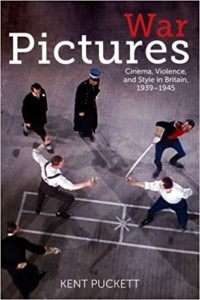 In this original and engaging work, Kent Puckett looks at how British filmmakers imagined, saw, and sought to represent its war during wartime through film. The Second World War posed unique representational challenges to Britain’s filmmakers. Because of its logistical enormity, the unprecedented scope of its destruction, its conceptual status as total, and the way it affected everyday life through aerial bombing, blackouts, rationing, and the demands of total mobilization, World War II created new, critical opportunities for cinematic representation.
In this original and engaging work, Kent Puckett looks at how British filmmakers imagined, saw, and sought to represent its war during wartime through film. The Second World War posed unique representational challenges to Britain’s filmmakers. Because of its logistical enormity, the unprecedented scope of its destruction, its conceptual status as total, and the way it affected everyday life through aerial bombing, blackouts, rationing, and the demands of total mobilization, World War II created new, critical opportunities for cinematic representation.
Beginning with a close and critical analysis of Britain’s cultural scene, War Pictures examines where the historiography of war, the philosophy of violence, and aesthetics come together. Focusing on three films made in Britain during the second half of the Second World War–Michael Powell and Emeric Pressburger’s The Life and Death of Colonel Blimp (1943), Lawrence Olivier’s Henry V (1944), and David Lean’s Brief Encounter (1945)–Puckett treats these movies as objects of considerable historical interest but also as works that exploit the full resources of cinematic technique to engage with the idea, experience, and political complexity of war. By examining how cinema functioned as propaganda, criticism, and a form of self-analysis, War Pictures reveals how British filmmakers, writers, critics, and politicians understood the nature and consequence of total war as it related to ideas about freedom and security, national character, and the daunting persistence of human violence. While Powell and Pressburger, Olivier, and Lean developed deeply self-conscious wartime films, their specific and strategic use of cinematic eccentricity was an aesthetic response to broader contradictions that characterized the homefront in Britain between 1939 and 1945. This stylistic eccentricity shaped British thinking about war, violence, and commitment provided both an answer to and an expression of a more general violence.
Although War Pictures focuses on a particularly intense moment in time, Puckett uses that particularity to make a larger argument about the pressure that war puts on aesthetic representation, past and present. Through cinema, Britain grappled with the paradoxical notion that, in order to preserve its character, it had not only to fight and to win but also to abandon exactly those old decencies, those “sporting-club rules,” that it sought also to protect.
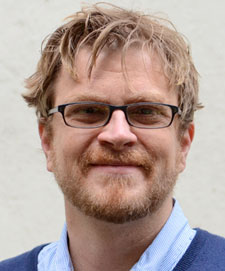 Kent Puckett is Associate Professor of English at the University of California, Berkeley, and a member of the Representations editorial board. Puckett’s previous publications include Bad Form: Social Mistakes and the Nineteenth-Century Novel (Oxford, 2008) and Narrative Theory: A Critical Introduction (Cambridge, 2016).
Kent Puckett is Associate Professor of English at the University of California, Berkeley, and a member of the Representations editorial board. Puckett’s previous publications include Bad Form: Social Mistakes and the Nineteenth-Century Novel (Oxford, 2008) and Narrative Theory: A Critical Introduction (Cambridge, 2016).

